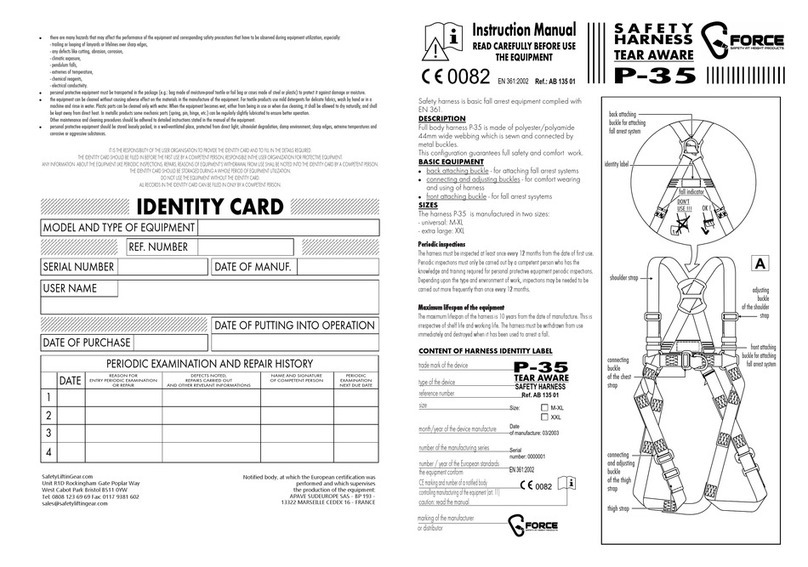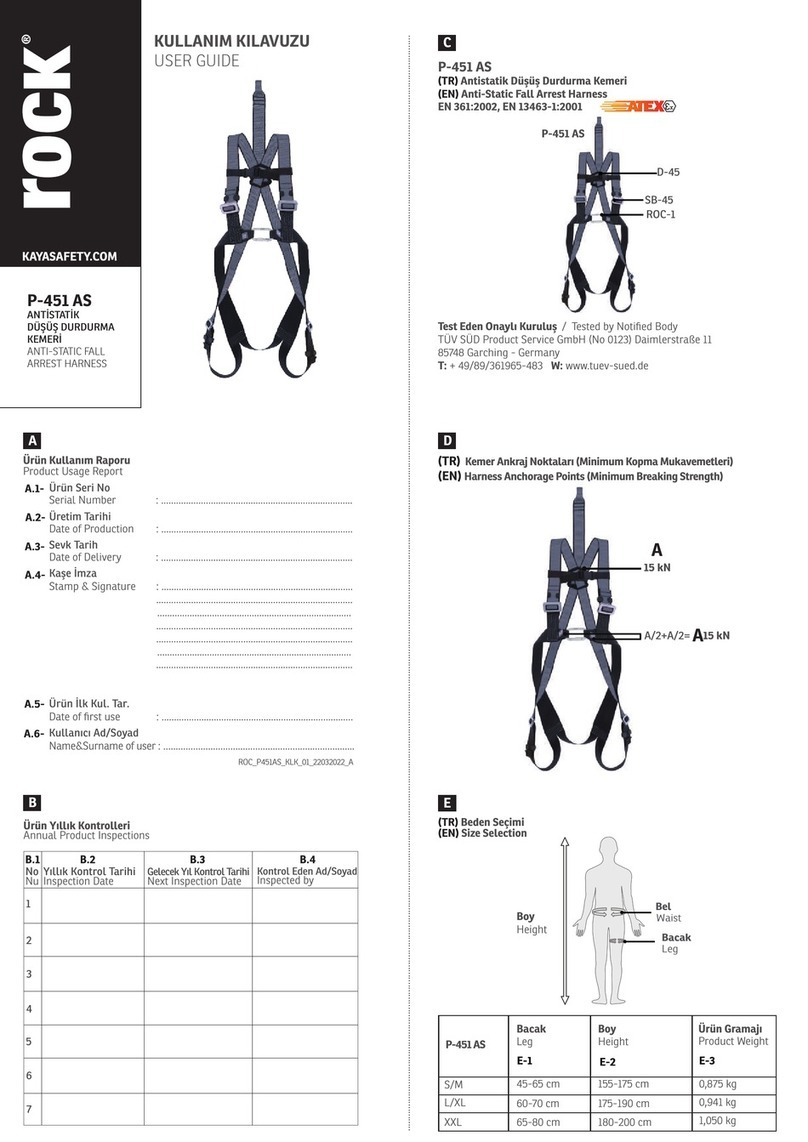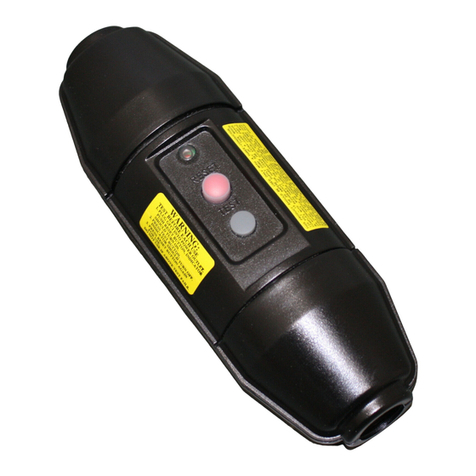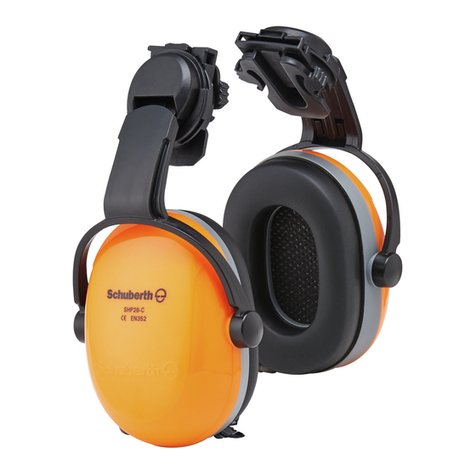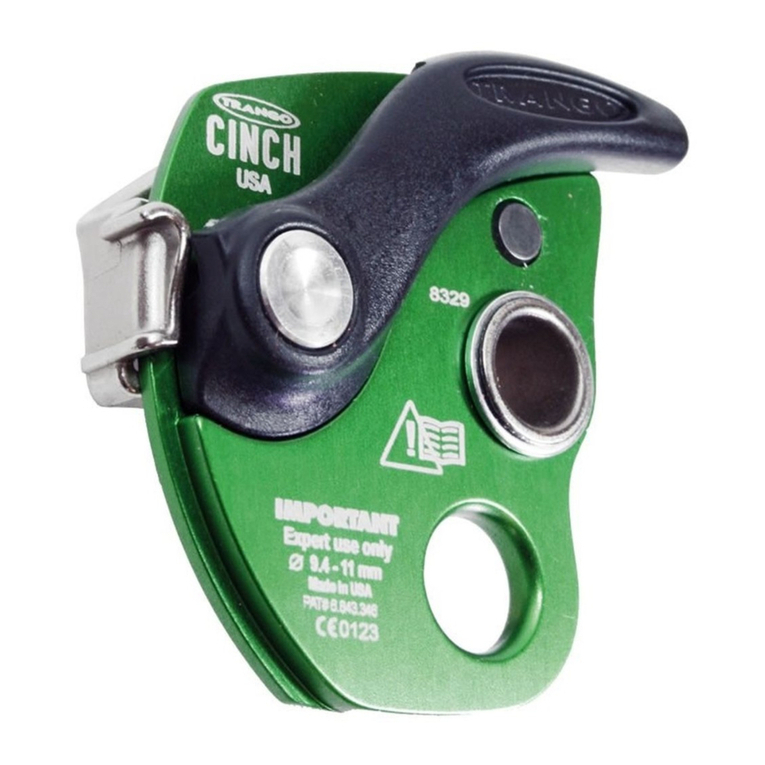
12. Frontal - The frontal attachment serves as a ladder climbing connection for guided type fall
arresters where there is no chance to fall in a direction other than feet rst, or may be used for
work positioning. Supporting the user, post fall or during work positioning, by the frontal
attachment will result in a sitting body position, with the upper torso upright, with weight
concentrated on the thighs and buttocks. When supported by the frontal attachment the design
of the Full Body Harness shall direct load directly around the thighs and under the buttocks by
means of the sub-pelvic strap. If the frontal attachment is used for fall arrest, the competent
person evaluating the application should take measures to ensure that a fall can only occur feet
rst. This may include limiting the allowable free fall distance.
13. Shoulder - The shoulder attachment elements shall be used as a pair, and are an
acceptable attachment for rescue and entry/retrieval. The shoulder attachment elements
shall not be used for fall arrest. It is recommended that the shoulder attachment elements
be used in conjunction with a yoke which incorporates a spreader element to keep the Full
Body Harness shoulder straps separate.
14. Waist, Rear - The waist, rear attachment shall be used solely for travel restraint. The waist,
rear attachment element shall not be used for fall arrest. Under no circumstances is it
acceptable to use the waist, rear attachment for purposes other than travel restraint. The
waist, rear attachment shall only be subjected to minimal loading through the waist of the
user, and shall never be used to support the full weight of the user.
15. Hip - The hip attachment elements shall be used as a pair, and shall be used solely for
work positioning. The hip attachment elements shall not be used for fall arrest. Hip
attachments are often used for work positioning by arborists, utility workers climbing poles
and construction workers tying rebar and climbing on form walls. Users are cautioned
against using the hip attachment elements (or any other rigid point on the Full Body
Harness) to store the unused end of a fall arrest lanyard, as this may cause a tripping hazard,
or, in the case multiple leg lanyards, could cause adverse loading to the Full Body Harness
and the wearer through the unused portion of the lanyard.
16. Suspension seat - The suspension seat attachment elements shall be used as a pair, and
shall be used solely for work positioning. The suspension seat attachment elements shall not
be used for fall arrest. Suspension seat attachments are often used for prolonged work
activities where the user is suspended, allowing the user to sit on the suspension seat formed
between the two attachment elements. An example of this use would be window washers on
large buildings.
Users of personal fall arrest systems shall, at a minimum, comply with all manufacturer
instructions regarding the inspection, maintenance and storage of equipment. The user’s
organization shall retain the manufacturer’s instructions and make them readily available to
all users. See ANSI/ASSE Z359.2, Minimum Requirements for a Comprehensive Managed Fall
Protection Program, regarding user inspection, maintenance and storage of equipment.
1. In addition to the inspection requirements set forth in the manufacturer’s instructions,
the equipment shall be inspected by the user before each use and, additionally, by a
competent person, other than the user, at interval of no more than one year for:
USER INSPECTION, MAINTENANCE AND STORAGE OF EQUIPMENT
Absence or illegibility of markings.
Absence of any elements aecting the equipment form, t or function.
Evidence of defects in, or damage to, hardware elements including cracks, sharp edges,
deformation, corrosion, chemical attack, excessive heating, alteration and excessive wear.
Maintenance, Service and Storage
Labels
• Chest strap to be six inches below the throat
• Torso length adjustment does not apply unnecessary pressure on the shoulder or allows leg
straps to sag
• Dorsal D-ring is in between the shoulder blades
• Leg straps tightened to allow no more than a at hand to pass through
7.1 Cleaning: Clean full body harness with a mild bleach-free detergent and then rinse. Allow
for harness to airdry. Do not allow excessive build-up of dirt, paint, or other agents that may
cause damage or hardening of the webbing bers.
8.2 Storage: Hang to store, do not allow in direct sunlight. Avoid exposure to chemical agents
and vapors, airborne debris, and water ingress. Store in a cool, dry and clean environment
away from sunlight.
Stored units tagged as“UNUSABLE” in a clearly marked area to prevent inadvertent use.
8.3 Service: Upon permanent removal from service, cut the harness straps or otherwise
render the harness unusable before disposing of it or return to Fusionclimb.
Note: This information from the Z359.11 standard is required to be included in the
instruction manual for the end user: ANSI/ASSP Z359 Requirements for Proper Use and
Maintenance of Full Body Harnesses (Note: These are general requirements and information
provided by ANSI/ASSE Z359, the Manufacturer of this equipment may impose more
stringent restrictions on the use of the products they manufacture, see the Manufacturer’s
instructions.)
1. It is essential that the users of this type of equipment receive proper training and
instruction, including detailed procedures for the safe use of such equipment in their work
application. ANSI/ASSE Z359.2, Minimum Requirements for a Comprehensive Managed Fall
Protection Program, establishes guidelines and requirements for an employer’s managed fall
protection program, including policies, duties and training; fall protection procedures;
eliminating and controlling fall hazards; rescue procedures; incident investigations; and
evaluating program eectiveness.
2. Correct t of a Full Body Harness is essential to proper performance. Users must be trained
to select the size and maintain the t of their Full Body Harness.
3. Users must follow manufacturer’s instructions for proper t and sizing, paying particular
attention to ensure that buckles are connected and aligned correctly, leg straps and
shoulder straps are kept snug at all times, chest straps are located in the middle chest area
and leg straps are positioned and snug to avoid contact with the genitalia should a fall occur.
4. Full Body Harnesses which meet ANSI/ASSE Z359.11 are intended to be used with other
components of a Personal Fall Arrest system that limit maximum arrest forces to 1800 pounds
(8kN) or less.
5. Suspension intolerance, also called suspension trauma or orthostatic intolerance, is a serious
condition that can be controlled with good harness design, prompt rescue and post fall
suspension relief devices. A conscious user may deploy a suspension relief device allowing the
user to remove tension from around the legs, freeing blood ow, which can delay the onset of
suspension intolerance. An attachment element extender is not intended to be attached
directly to an anchorage or anchorage connector for fall arrest. An energy absorber must be
used to limit maximum arrest forces to 1800 pounds (8kN). The length of the attachment
element extender may aect free fall distances and free fall clearance calculations.
6. Full Body Harness (FBH) Stretch, the amount the FBH component of a personal fall arrest
system will stretch and deform during a fall, can contribute to the overall elongation of the
system in stopping a fall. It is important to include the increase in fall distance created by FBH
Stretch, as well as the FBH connector length, the settling of the user’s body in the FBH and all
other contributing factors when calculating total clearance required for a particular fall arrest
system.
7. When not in use, unused lanyard legs that are still attached to a Fully Body Harness D-ring
should not be attached to a work positioning element or any other structural element on the
Full Body Harness unless deemed acceptable by the competent person and manufacturer of the
lanyard. This is especially important when using some types of “Y” style lanyards, as some load
may be transmitted to the user through the unused lanyard leg if it is not able to release from
the harness. The lanyard parking attachment is generally located in the sternal area to help
reduce tripping and entanglement hazards.
8. Loose ends of straps can get caught in machinery or cause accidental disengagement of an
adjuster. All Full Body Harnesses shall include keepers or other components which serve to
control the loose ends of straps.
9. Due to the nature of soft loop connections, it is recommended that soft loop attachments
only be used to connect with other soft loops or carabiners. Snap hooks should not be used
unless approved for the application by the manufacturer.
Sections 11-17 provide additional information concerning the location and use of various
attachments that may be provided on this FBH.
10. Dorsal - The dorsal attachment element shall be used as the primary fall arrest attachment,
unless the application allows the use of an alternate attachment. The dorsal attachment may
also be used for travel restraint or rescue. When supported by the dorsal attachment during a
fall, the design of the Full Body Harness shall direct load through the shoulder straps supporting
the user, and around the thighs. Supporting the user, post fall, by the dorsal attachment will
result in an upright body position with a slight lean to the front with some slight pressure to the
lower chest. Considerations should be made when choosing a sliding versus xed dorsal
attachment element. Sliding dorsal attachments are generally easier to adjust to dierent user
sizes, and allow a more vertical rest position post fall, but can increase FBH Stretch.
11. Sternal - The sternal attachment may be used as an alternative fall arrest attachment in
applications where the dorsal attachment is determined to be inappropriate by a competent
person, and where there is no chance to fall in a direction other than feet rst. Accepted
practical uses for a sternal attachment include, but are not limited to, ladder climbing with a
guided type fall arrester, ladder climbing with an overhead self-retracting lifeline for fall arrest,
work positioning and rope access. The sternal attachment may also be used for travel restraint
or rescue. When supported by the sternal attachment during a fall, the design of the Full Body
Harness shall direct load through the shoulder straps supporting the user, and around the
thighs. Supporting the user, post fall, by the sternal attachment will result in roughly a sitting or
cradled body position with weight concentrated on the thighs, buttocks and lower back.
Supporting the user during work positioning by this sternal attachment will result in an
approximate upright body position. If the sternal attachment is used for fall arrest, the
competent person evaluating the application should take measures to ensure that a fall can
only occur feet rst. This may include limiting the allowable free fall distance. It may be possible
for a sternal attachment incorporated into an adjustment style chest strap to cause the chest
strap to slide up and possibly choke the user during a fall, extraction, suspension, etc. The
competent person should consider Full Body Harness models with a xed sternal attachment for
these applications.
Labels must be present and legible ANSI Z359.11 Annex A
7
8
9
To check proper t, a at hand may pass under the strap, but cannot form a st.
P4












